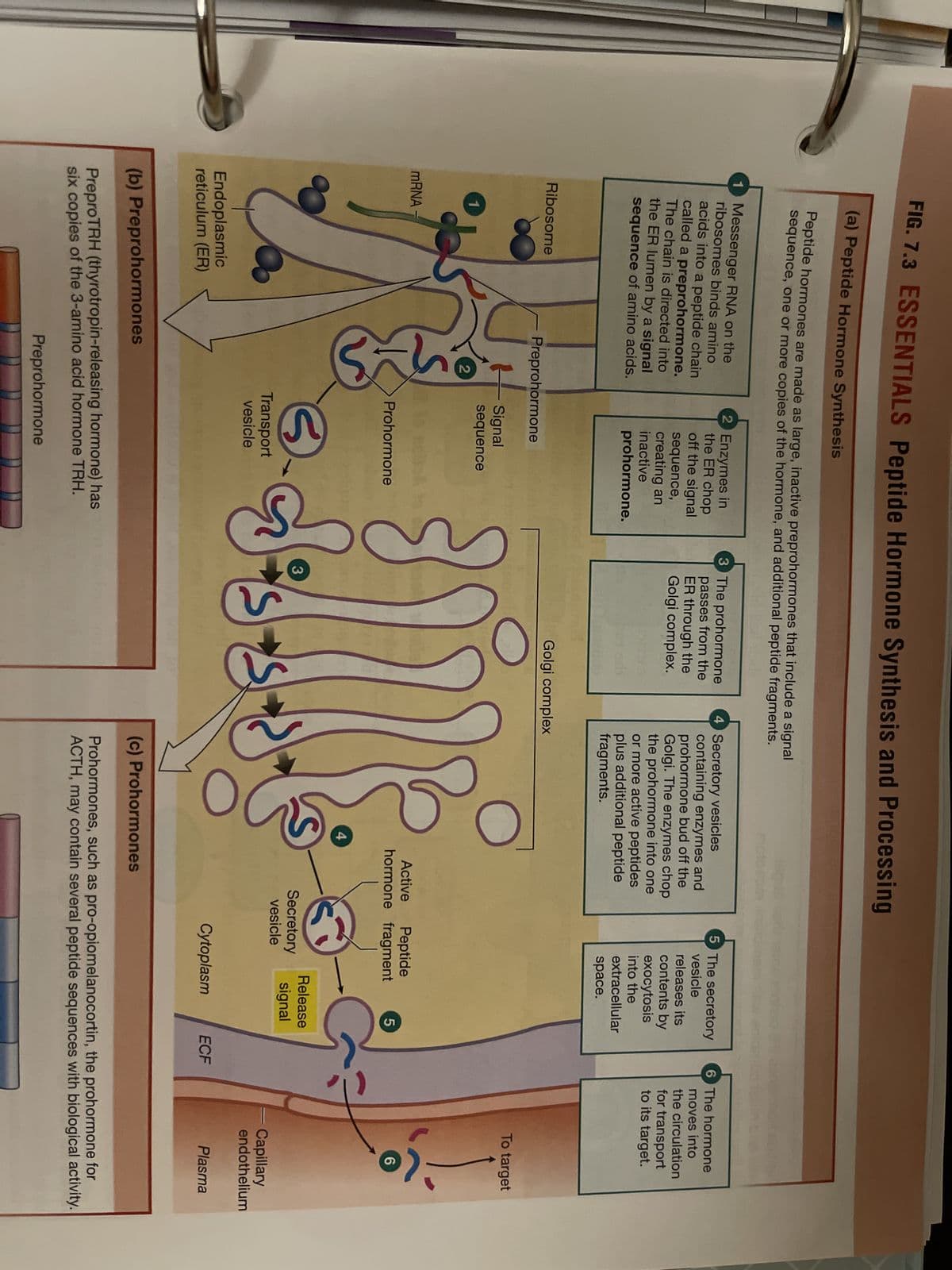FIG. 7.3 ESSENTIALS Peptide Hormone Synthesis and Processing (a) Peptide Hormone Synthesis Peptide hormones are made as large, inactive preprohormones that include a signal sequence, one or more copies of the hormone, and additional peptide fragments. Messenger RNA on the ribosomes binds amino acids into a peptide chain called a preprohormone. The chain is directed into the ER lumen by a signal sequence of amino acids. Ribosome mRNA Endoplasmic reticulum (ER) 2 Enzymes in the ER chop off the signal sequence, creating an inactive prohormone. Preprohormone Signal sequence Prohormone Transport vesicle (b) Preprohormones PreproTRH (thyrotropin-releasing hormone) has six copies of the 3-amino acid hormone TRH. Preprohormone 3 The prohormone passes from the ER through the Golgi complex. 4 Secretory vesicles containing enzymes and prohormone bud off the Golgi. The enzymes chop the prohormone into one or more active peptides plus additional peptide fragments. amus J Golgi complex The secretory vesicle releases its contents by exocytosis into the extracellular space. Active Peptide hormone fragment 5 (c) Prohormones Secretory vesicle Release signal Cytoplasm ECF 6 The hormone moves into the circulation for transport to its target. To target Capillary endothelium Plasma Prohormones, such as pro-opiomelanocortin, the prohormone for ACTH, may contain several peptide sequences with biological activity.
FIG. 7.3 ESSENTIALS Peptide Hormone Synthesis and Processing (a) Peptide Hormone Synthesis Peptide hormones are made as large, inactive preprohormones that include a signal sequence, one or more copies of the hormone, and additional peptide fragments. Messenger RNA on the ribosomes binds amino acids into a peptide chain called a preprohormone. The chain is directed into the ER lumen by a signal sequence of amino acids. Ribosome mRNA Endoplasmic reticulum (ER) 2 Enzymes in the ER chop off the signal sequence, creating an inactive prohormone. Preprohormone Signal sequence Prohormone Transport vesicle (b) Preprohormones PreproTRH (thyrotropin-releasing hormone) has six copies of the 3-amino acid hormone TRH. Preprohormone 3 The prohormone passes from the ER through the Golgi complex. 4 Secretory vesicles containing enzymes and prohormone bud off the Golgi. The enzymes chop the prohormone into one or more active peptides plus additional peptide fragments. amus J Golgi complex The secretory vesicle releases its contents by exocytosis into the extracellular space. Active Peptide hormone fragment 5 (c) Prohormones Secretory vesicle Release signal Cytoplasm ECF 6 The hormone moves into the circulation for transport to its target. To target Capillary endothelium Plasma Prohormones, such as pro-opiomelanocortin, the prohormone for ACTH, may contain several peptide sequences with biological activity.
Biochemistry
6th Edition
ISBN:9781305577206
Author:Reginald H. Garrett, Charles M. Grisham
Publisher:Reginald H. Garrett, Charles M. Grisham
Chapter32: The Reception And Transmission Of Extracellular Information
Section: Chapter Questions
Problem 9P
Related questions
Question

Transcribed Image Text:FIG. 7.3 ESSENTIALS Peptide Hormone Synthesis and Processing
(a) Peptide Hormone Synthesis
Peptide hormones are made as large, inactive preprohormones that include a signal
sequence, one or more copies of the hormone, and additional peptide fragments.
1 Messenger RNA on the
ribosomes binds amino
acids into a peptide chain
called a preprohormone.
The chain is directed into
the ER lumen by a signal
sequence of amino acids.
Ribosome
1
mRNA-
Endoplasmic
reticulum (ER)
Preprohormone
2
3
(b) Preprohormones
2 Enzymes in
the ER chop
off the signal
sequence,
creating an
inactive
prohormone.
Signal
sequence
Prohormone
Transport
vesicle
passes from the
3 The prohormone 4 Secretory vesicles
containing enzymes and
prohormone bud off the
Golgi. The enzymes chop
the prohormone into one
or more active peptides
plus additional peptide
fragments.
PreproTRH (thyrotropin-releasing hormone) has
six copies of the 3-amino acid hormone TRH.
Preprohormone
ER through the
Golgi complex.
Golgi complex
Tim
3
d
C
4
5 The secretory
vesicle
releases its
contents by
exocytosis
into the
extracellular
space.
Active Peptide
hormone fragment
(c) Prohormones
Secretory
vesicle
5
Release
signal
Cytoplasm
ECF
6 The hormone
moves into
the circulation
for transport
to its target.
To target
6
Capillary
endothelium
Plasma
Prohormones, such as pro-opiomelanocortin, the prohormone for
ACTH, may contain several peptide sequences with biological activity.
Expert Solution
This question has been solved!
Explore an expertly crafted, step-by-step solution for a thorough understanding of key concepts.
Step by step
Solved in 2 steps

Follow-up Questions
Read through expert solutions to related follow-up questions below.
Follow-up Question
10. Put the steps involved in generation and release of peptide hormones in the correct order:
1)cleavage into active hormone
2) transport into blood capillary
3)mRNA translation and preprohormone entrance into the ER
4) release signal into ECF
5)vesicular transport into Golgi apparatus
6)signal sequence peptide cleavage into prohormone
Solution
Knowledge Booster
Learn more about
Need a deep-dive on the concept behind this application? Look no further. Learn more about this topic, biology and related others by exploring similar questions and additional content below.Recommended textbooks for you

Biochemistry
Biochemistry
ISBN:
9781305577206
Author:
Reginald H. Garrett, Charles M. Grisham
Publisher:
Cengage Learning

Anatomy & Physiology
Biology
ISBN:
9781938168130
Author:
Kelly A. Young, James A. Wise, Peter DeSaix, Dean H. Kruse, Brandon Poe, Eddie Johnson, Jody E. Johnson, Oksana Korol, J. Gordon Betts, Mark Womble
Publisher:
OpenStax College

Biology: The Unity and Diversity of Life (MindTap…
Biology
ISBN:
9781305073951
Author:
Cecie Starr, Ralph Taggart, Christine Evers, Lisa Starr
Publisher:
Cengage Learning

Biochemistry
Biochemistry
ISBN:
9781305577206
Author:
Reginald H. Garrett, Charles M. Grisham
Publisher:
Cengage Learning

Anatomy & Physiology
Biology
ISBN:
9781938168130
Author:
Kelly A. Young, James A. Wise, Peter DeSaix, Dean H. Kruse, Brandon Poe, Eddie Johnson, Jody E. Johnson, Oksana Korol, J. Gordon Betts, Mark Womble
Publisher:
OpenStax College

Biology: The Unity and Diversity of Life (MindTap…
Biology
ISBN:
9781305073951
Author:
Cecie Starr, Ralph Taggart, Christine Evers, Lisa Starr
Publisher:
Cengage Learning